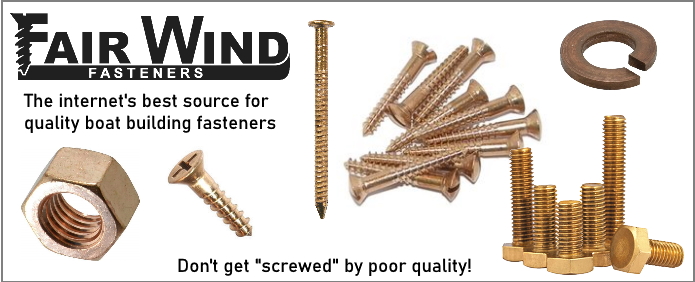- Home
- Your Boats
- Deck Beams
Deck Beams
The deck beams of a wooden boat do more than simply support the deck.
They also have to withstand considerable stresses and loadings.
The most obvious loadings are the downward ones, such as supporting the weight of anyone walking on deck and the weight of cabins and such like.
The deck structure will also be subject to stresses imposed between the healing motion and the righting motion caused by the ballast keel.
It also has to cope with the stresses imposed by winches, mooring cleats and any other deck hardware.
Beams need not only to be strong but built of rot-resistant wood as they will be difficult to replace when planked over.
And just as importantly, all the beams joints need to be of sufficient strength and integrity to transfer the loadings throughout the hull.

Deck beams.
Ordinary or auxiliary beams are those which do not support a hatch or deck opening.
King, strong or main beams are those which support hatches, cabins masts and the like.
Half beams are those which join hatch or cabin carlines.
Sawn beams must either be cut from timber which has the grain following the curve or lumber sufficiently wide to avoid splitting.
Laminating deck beams is a much more cost effective use of boat building timber and they can be just as strong.
However, as the curvature of the beams will vary, individual jigs my have to be made.
Allowance should be made for the tendency of laminated beams to collapse slightly when taken off the gluing jig.

Carlines.
Carlines are the fore and aft beams that support the sides of cabins hatches and cockpits.
Carlines are supported by main beams but in their turn they not only support the hatch or cabin but also the inside ends of the half beams.
In some cases it is necessary to reinforce these with tie rods.
Before fitting carlines consider how the Cabin Trunk is to be constructed.
Mast Partners.
The Mast Partners provide a reinforced frame to spread the horizontal loads of a keel stepped mast.
To spread these loads across the deck and out to the hull, the partners should be placed between to two full-length main beams.
It is also advisable to reinforce these with lodging knees, although plywood covered decking will help with spreading the loads.
It is not advisable for throat stepped masts to emerge through the cabin top as it is unlikely to be able to support these transverse loads.
Tie-Rods or through bolts are needed to prevent the two deck beams from parting and to hold the partners down.
Any hardware such as halyard blocks, pinrails and the like should be bolted through the deck and partners.
Partners for un-stayed masts need to be stronger than those for gaff rigged which, in turn need to be stronger the those for stayed Marconi rigged masts.
Knees.

Hanging knees act as vertical supports for joints while lodging knees are used to join and strengthen horizontal sections.
Knees can be added to joints that are highly stressed such as main deck beam to hull joints and to mast partners.
Hanging knees can also be used as an alternative to or in addition to sheer clamps or beam shelf joints.
Sheer Clamp / Beam Shelf.

When is a clamp a shelf and a shelf a clamp?
Well it seems it depends on where you live.
In order to try to avoid confusion I shall refer to the beam shelf as being the horizontal piece the deck beam rests on, the clamp as the strake running along the top inside edge of the planking.
The most common method for connecting deck beams to the hull is via a combination of sheer clamp and beam shelf.

The advantage of the shelf / clamp method is that not only is the beam supported but the loads are evenly spread and the hull sides are restrained from spreading.
The beam ends must also be fastened strongly to the frame heads as well as to the shelf / clamp.
affiliate linksJoints.

All joints between beams carlines and hull sides must be carefully fitted to allow for the sweep of the deck.
Joints should be notched to prevent movement.
Beam to carline joints are often notched with a taper to prevent them from slipping downwards.
Tapered joints also add strength due to the wedging effect as pressure is applied downwards, however they will also have to be fastened down.
Half dovetails are used to help tie carline to beam to hull.
The strength of the joints will be affected by the type of covering used on the deck.
Sheet plywood securely fastened to the deck beams will help to spread the loads in all horizontal directions, while laid planks on their own will only spread them in the fore and aft direction.
Previous posts
See What Others Have Posted
Resurrection of Henry. B. Nevins, Inc 24’ Double Ended Launch #187 built on City Island New York USA in 1920
Greeting Everyone.
Of all the many things I’ve tried in my life, sailing has been by far the most rewarding.
Even after 45-years at the helm, …
Very Interesting
This was really informative and clarified a number of issues that I have had question about so was a really great read.
Now I come to my point I have …














